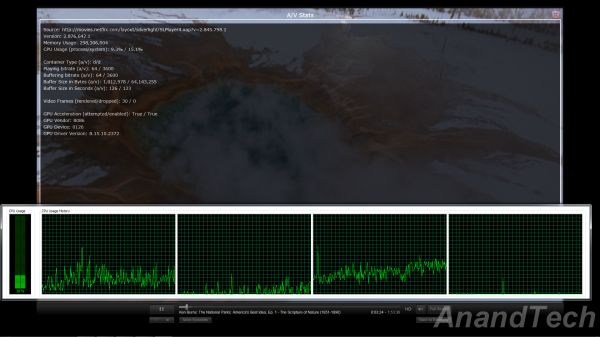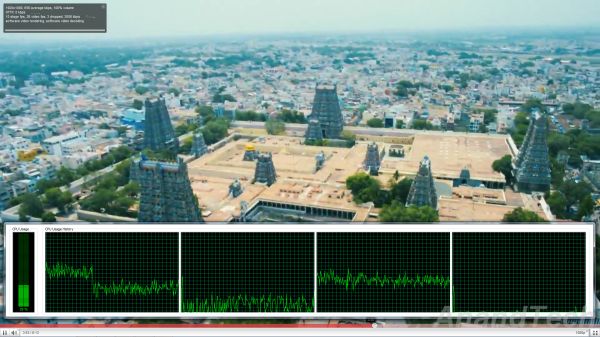ASRock CoreHT 252B Review
by Ganesh T S on September 2, 2011 3:45 AM EST- Posted in
- HTPC
- Intel
- ASRock
- Media Streamer
The ASRock CoreHT 252B is covered quite nicely with respect to networking hardware. With support for both Gigabit Ethernet and 802.11n, it really doesn't matter if you keep the unit beyond cable reach from the router. All our network streaming tests were carried out with a 300 Mbps 802.11n network (currently provided in my lab location by a RT-N16 802.11n gigabit router from Asus). We were easily able to stream HD clips of more than 50 Mbps. HD YouTube videos and HD Netflix streaming had no issues.
While on the topic of network streaming, let us take a brief look at how the system performs while accessing online video services. We used Flash 10.3 in Firefox 4 with Intel Graphics Driver v2372 for testing. The first set of screenshots below show the CPU usage while playing back a 1080p YouTube video with and without hardware acceleration enabled. This is the same clip used in all the other SFF HTPC reviews.
1080p YouTube HD Streaming without Hardware Acceleration

1080p YouTube HD Streaming with Hardware Acceleration (Flash in Firefox)
Unfortunately, enabling hardware acceleration in the Flash properties seems to result in only accelerated video rendering. The decode still ends up being done in software. This accounts for the ~5% decrease in CPU usage when hardware acceleration is enabled. Just before posting the review, we also confirmed that the issue still exists on IE9 / Firefox 6.0 with Flash 10.3.183.7. Another puzzling aspect was the fact that we could get hardware accelerated decoding for some videos occasionally.

1080p YouTube HD Streaming with Hardware Acceleration (Flash in IE9)
It looks like the Adobe Flash Player has some trouble in hooking up to the Intel DXVA library. Both AMD and NVIDIA platforms support GPU acceleration for Flash without issues. It is disappointing to note that the largest GPU vendor (in terms of install base) still hasn't got this working right.
Netflix streaming, on the other hand, uses Microsoft's Silverlight technology. Unlike Flash, hardware acceleration for the video decode process is not controlled by the user. It is upto the server side code to attempt GPU acceleration. Thankfully, Netflix does try to take advantage of the GPU's capabilities. This is evident from the A/V stats recorded while streaming a Netflix HD video at the maximum possible bitrate of 3.8 Mbps. While the video is definitely not 1080p, we observe that the CPU utilization of around 18% is lower than the CPU usage for a 1080p YouTube video.

Netflix HD Streaming with Hardware Acceleration
Users of media streamers streaming online videos often have to put up with messages of the sort 'This content is not available on TV connected devices' or need to queue up the videos on a PC before accessing them through their media streamer box. HTPC users don't need to worry about any such limitations.
On a side note, it is disappointing to see Netflix restrict its 1080p / DD+ 5.1 offerings to the PS3 and Roku 2. It is the PC platform which launched the streaming business for Netflix. It would be good if they do not relegate HTPC users to being second string consumers as their popularity grows.











54 Comments
View All Comments
Death666Angel - Friday, September 2, 2011 - link
<<Well, the reviewer only used Windows, hence assuming that one pays for it.>>That would be true, except for the part where in the table on the first page, he writes:
"Operating System Windows 7 Home Premium 64-bit (Retail unit is barebones)"
I agree, however, that he could have stated it clearer in the text when he mentioned the software being shipped with the system ("Our review unit shipped with Windows 7 x64 Ultimate and a OEM version of Cyberlink PowerDVD for Blu-Ray playback.").
ganeshts - Friday, September 2, 2011 - link
Guys, I am keeping track of the developments in the Linux HTPC space.As soon as we can get to a point where it is possible to play Blu-rays with menus (we can already playback encrypted Blu-rays with MakeMKV installed, just not with menus -- this was the state when I last looked at it), we will carry out a detailed Linux HTPC article.
Rick83 - Friday, September 2, 2011 - link
Thanks, looking forward to that!bobbozzo - Friday, September 2, 2011 - link
Hi Ganesh,I don't care about BD so I'd like to see a review even if BD menus don't work.
Thanks for all the HTPC articles!
Miles Prower - Saturday, September 3, 2011 - link
I'm considering buying this machine too, as both a lightweight desktop PC (hey, why not) and a HTPC. Both solutions running Linux.I'd llove to see a review considering XBMC performance and hardware support!
cjs150 - Friday, September 2, 2011 - link
"The unit has a noise level of less than 36 dB at full load "Not good enough. The system needs to be much better 30dB or less. Then there is the issue of how noisy is the Blu-ray drive. In my AV rack the one aspect which really annoys me is the Sony Blu ray player which is clearly audible at quiet points in movies. So would really like to know how loud the optical drive is (why do case manufacturers no include some dampening?)
Having said that it is clearly a very good system . Problem is that Zotac have just announced their AD10 nano system. Whilst it is over priced and lacks an optical drive (not a problem for me as store movies to NAS), in a main room it just looks a far better piece of kit, and a lot smaller (and allegedly quieter)
pvdw - Friday, September 2, 2011 - link
"27 dB during Disc Playback"cjs150 - Friday, September 2, 2011 - link
Oops missed that in the charts.Much better, but I do wonder how much of that noise is due to the Blu ray drive - 22.4 dB on idle and 27 dB on Blu ray playback does not really help me - was this playback from HD or from the optical drive. I can believe the number if from HD, I do not believe the number if from optical drive, but if it is correct then I am impressed. Maybe it is just me, but case manufacturers have spent some time putting vibration dampening grommets for hard disks but never for the optical drives - why? A bit of care might reduce the noise considerably.
The problem is that we keep getting quoted dB and how something is so quiet it is effectively silent when clearly it is not. The standard I work to is very simple. If I can hear a computer during a quiet section of a movie or a song, than it is too loud.
ganeshts - Friday, September 2, 2011 - link
Disc = optical drive. The extra noise is due to the operation of the ODD. Yes, I agree with your metric that if people hear it, it is noisy. However, different people have different tolerance / hearing levels. So, you do need to have some sort of base metric to compare against. For example, at 2 ft, I find 36 dB quite audible. But, only during quiet scenes in the video.Rick83 - Friday, September 2, 2011 - link
note that the measurements were done at 2 feet and not the more or less standardized meter. I'm not going to make the transformation now, as I'm not to keen to get into exponential scaling at this time of day, but it's always important to keep the context of db(A) measures in mind when comparing values.